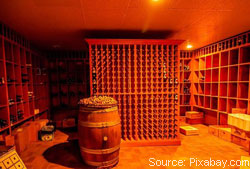 Building a wine cellar in your home might not be on your immediate to-do list, but with some planning you can easily build one using these helpful tips and suggestions. If you don't want to build one in your existing home because you'll be moving soon, perhaps your next home will have one. Just be sure to carefully pack and move your cherished bottles and stemware properly!
Building a wine cellar in your home might not be on your immediate to-do list, but with some planning you can easily build one using these helpful tips and suggestions. If you don't want to build one in your existing home because you'll be moving soon, perhaps your next home will have one. Just be sure to carefully pack and move your cherished bottles and stemware properly!
Consider these factors when converting a room into wine storage or building an entirely new area in your new or current home.
Desired capacity
The overall dimensions of the room will put a cap on the number of bottles you will be able to store properly in your new wine cellar.
Electricity and backup power
At the very least, you will need a light source and an outlet for the cooling system. The cooler is best allocated on a separate circuit (the larger the room, the more important that will be.) Can you do the wiring yourself, or will you need to hire an electrician? A backup power source will come in handy if there is a power outage in the summer.
Wall thickness
If the room is completely interior to the house, you may be OK with the insulation levels in the wall. However, if any of the walls are an exterior wall that receives a lot of sun, making the wall thicker will be beneficial.
Ceilings and floors
Both the ceiling and floor need to be insulated in your wine room. If the ceiling is also your home's roof, then you'll need at least 9 inches minimum of insulation. If the floor is made of concrete, you may wish to build a false floor.
Vapor barrier
This item is a must, all the way around on the warm side. A 6mm poly film is most commonly used in wine rooms. The vapor barrier prevents the cooled air from the cellar from leaking into the walls. It's designed for heat loss and prevents the cool air from meeting the warmer air which will cause condensation and potentially lead to rot in your studs.
Door
A heavily insulated steel door would be ideal for your wine room, such as one that would be between a garage and house. A windowed door could be installed, but it would be less efficient and obviously let in unwanted light into the cellar. If choosing a door with windows or a room with a window, consider sealing it off or using it to vent any cooling unit you might use for the space.
Cooler placement
Ideally, the cooler won't be directly opposite the door if that is the longest wall and will be full of racks. You will also need to consider that you'll need access to the back of the cooler at least once a year to clean the cooling fins.
You also have options on where to put it if you're looking to convert a space you already have in your home.
A passive wine cellar is a wine cellar that doesn't require any conventional humidity or temperature control, so the location of a passive wine cellar is not overly critical. However, it is important to keep in mind that heat, light and vibration are harmful to the long-term storage of wine so be sure to pick a spot that stays cool throughout the year in your home, where you won't need to cover windows.
Location of your new wine cellar
- Unused space under the stairs
- A closet
- Build out a basement
- Extra bedroom or office
Storing your wine
After you've built your brand new wine cellar, it is important to properly care for your wine. Proper storage of your wine collection will protect your investment and ensure that you haven't wasted your time or money.
- Wine should be stored on its side at a slight slope with at least 50 percent of the cork in contact with the wine. The bottles should be rotated every so often to ensure the liquid keeps the cork lubricated and it will prevent any sediment from building up. Some sparkling wines can be stored vertically because the carbon dioxide will protect it from oxidation.
- The ambient temperature should be between 55 to 58 degrees, but frequent significant fluctuations in temperature can cause more damage than a constant temperature slightly above or below the ideal temperature. Wine will age more slowly if it's kept at a slightly lower temperature and quicker if itcs kept at a slightly higher temperature. But keep in mind wine doesn't have to become too hot to be completely ruined.
- The humidity should also be monitored and kept between 50 to 70 percent. This will also help protect the cork.